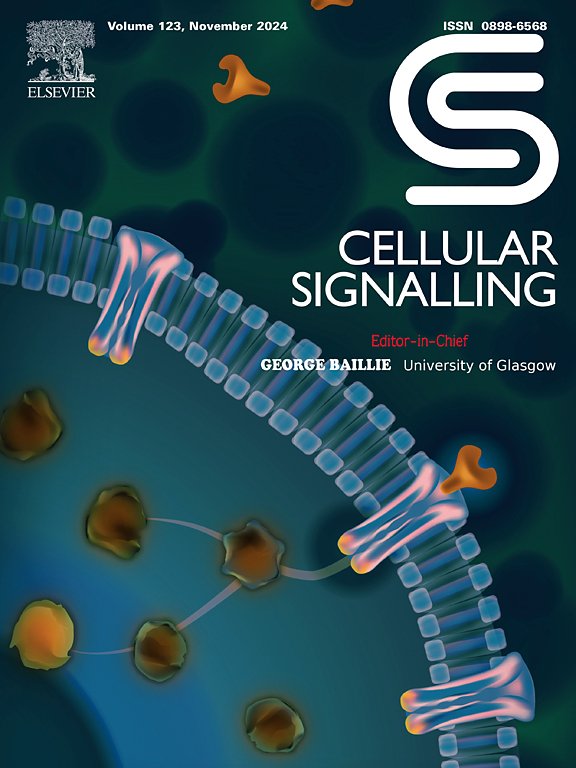RLIG1通过与ERK相互作用激活mTORC1信号通路,促进三阴性乳腺癌的增殖
IF 3.7
2区 生物学
Q2 CELL BIOLOGY
引用次数: 0
摘要
背景:三阴性乳腺癌(TNBC)的预后非常不利,需要开发新的治疗方法来提高治疗效果。导致TNBC发病的潜在机制尚不完全清楚。RNA 5 ' -磷酸与3 ' -OH连接酶1 (RLIG1)是人类发现的第一个RNA连接酶,可能与癌症的发生有关,但尚未见相关报道。我们观察到,与邻近的非癌组织相比,RLIG1在TNBC组织中的表达水平升高,高表达与TNBC患者的总生存率降低相关。方法采用生物信息学工具、细胞计数试剂盒-8 (CCK-8)、5-乙基-2′-脱氧尿苷(EdU)、集落形成、流式细胞术和western blotting检测TNBC中RLIG1的表达。通过质谱、共免疫沉淀和免疫荧光获得了机制见解。结果在体外实验中,我们发现干扰RLIG1可以有效地阻碍肿瘤细胞周期的进展和增殖,并在体内抑制肿瘤的生长。在机制上,RLIG1被鉴定为一种在TNBC细胞中刺激mTORC1信号通路的致癌基因。进一步证实了RLIG1与ERK的相互作用,RLIG1通过介导ERK磷酸化促进细胞周期转变和增殖。结论sour的研究为RLIG1的生物学作用提供了新的见解,表明其有可能成为TNBC的治疗靶点。本文章由计算机程序翻译,如有差异,请以英文原文为准。

RLIG1 promotes triple-negative breast cancer proliferation by activating mTORC1 signal pathway by interacting with ERK
Background
The prognosis of triple-negative breast cancer (TNBC) is notably unfavorable, necessitating the development of novel treatments to enhance therapeutic outcomes. The underlying mechanisms contributing to the pathogenesis of TNBC remain incompletely understood. RNA 5′-phosphate and 3’-OH ligase 1 (RLIG1) was found to be the first RNA ligase in humans and may be related to cancer development, but no reports have been reported. We observe RLIG1 elevated expression levels in TNBC tissues compared to adjacent non-cancerous tissues, with high RLIG1 expression correlating with reduced overall survival in TNBC patients.
Methods
We investigated RLIG1 in TNBC using bioinformatics tools, cell counting kit-8 (CCK-8), 5-ethynyl-2′-deoxyuridine (EdU), colony formation, flow cytometry, and western blotting. Mechanistic insights were gained via mass spectrometry, co-immunoprecipitation, and immunofluorescence.
Results
Here, we found that interfering with RLIG1 can effectively hinder tumor cell cycle progression and proliferation in vitro, as well as inhibit tumor growth in vivo. Mechanistically, RLIG1 was identified as an oncogene that stimulates the mTORC1 signaling pathway in TNBC cells. Furthermore, the interaction between RLIG1 and ERK was confirmed, with RLIG1 promoting cell cycle transition and proliferation through mediating ERK phosphorylation.
Conclusions
Our research offers novel insights into the biological role of RLIG1, indicating its potential as a therapeutic target for TNBC.
求助全文
通过发布文献求助,成功后即可免费获取论文全文。
去求助
来源期刊

Cellular signalling
生物-细胞生物学
CiteScore
8.40
自引率
0.00%
发文量
250
审稿时长
27 days
期刊介绍:
Cellular Signalling publishes original research describing fundamental and clinical findings on the mechanisms, actions and structural components of cellular signalling systems in vitro and in vivo.
Cellular Signalling aims at full length research papers defining signalling systems ranging from microorganisms to cells, tissues and higher organisms.
 求助内容:
求助内容: 应助结果提醒方式:
应助结果提醒方式:


